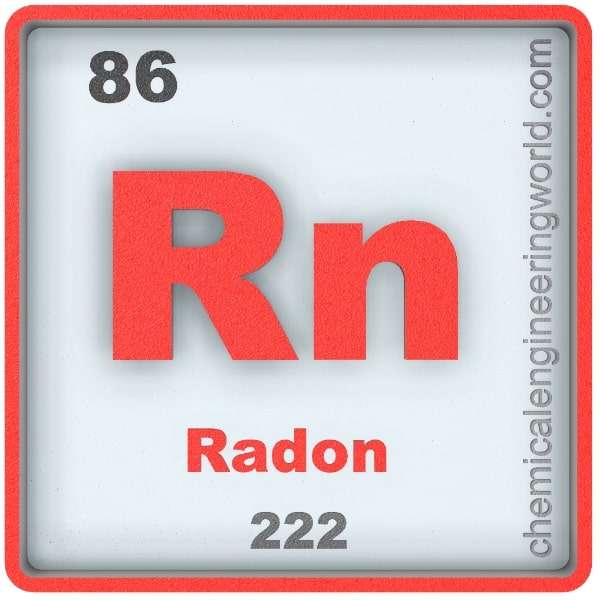Radon Element Properties and Information

Radon Element Properties and Information
Radon is 86th element on the periodic table. Elements are arranged in the periodic table on the basis of the atomic number. Atomic number is the number of protons in the nucleus of the atom. Radon has an atomic number of 86. It is located in the Group 18 and Period 6 of the periodic table of elements. It is denoted by the symbol ‘Rn’. The name comes from ‘Radium’ as Radon was first detected in the emission product during radioactive decay of radium.
Ernest Rutherford detected a gas being released from a thorium mineral sample in 1899; in the same year, Pierre and Marie Curie detected a radioactive gas emanating from radium. Those gases contained Radon; whose discovery is credited to Friedrich Ernst Dorn who investigated the gases emitted by radium which he observed in the year 1900.
Radon is produced naturally by the radioactive decay of radium-226 which is found in uranium ores, igneous & metamorphic rocks, phosphate rock, granite, schist, gnesis, limestone (to a lesser extent), and each square mile of the surface soil contains radium.
Physical Properties
- Radon is a radioactive colorless, odourless, and tasteless noble gas.
- The atomic mass of radon is (222).
- The melting point of radon is -71°C.
- The boiling point of radon is -62°C.
- The density of radon is 9.96 in S.I. units at 20°C.
- Radon is the densest among all noble gases.
- The radioluminescence emitted by radon changes from yellow to orange-red as the temperature is lowered.
- Radon liquid also glows like the gas because of the intense radiation being produced.
- Radon is more soluble in water than other noble gases.
- Radon is more soluble in organic liquids than it is in water.
- Radon has 39 known isotopes; none of which are stable.
Chemical Properties
- Radon is not very reactive.
- Radon can be oxidized by powerful oxidizing agents.
- Chemical nature of radon has not been investigated much because of the high cost of research and the radioactive nature.
Methods of Production
Radiation Decay: Radon is separated as a product from the gases evolving during radium decay.
Relevance in Chemical & Related Industries
Radon has no large scale industrial use.
Relevance in Other Industries
- Medicine: It is used in radiation therapy for cancer patients.
- Environmental studies: Radon is used in hydrological studies to find investigate interactions between underground water, rivers, and creeks. It is also used in geological studies to track air masses.
Health Effects on Exposure
Breathing: Radon is a gas hence the exposure generally happens by breathing. Long-term exposure can cause lung cancer.
Effects on Surroundings
The longest living radon isotope has a half-life of about 4 days; it means that it will decay and form harmless products in 4 days.
References:
https://en.wikipedia.org/wiki/Radon
https://www.lenntech.com/periodic/elements/rn.htm
































